
Mathematics, 24.08.2021 01:00 jpsaad00
Engagement Activity: The t test for two independent samples
Have you ever wanted to know if two groups differed?
Are women better or worse at crossword puzzles than men? Are people who use recreational drugs more likely to take risks in other areas of their lives than people who do not use drugs? Do premeds who were psychology majors have better bedside manners than those who were biochemistry majors? The independent-measures t test is a hypothesis test that uses two separate samples to evaluate the mean differences.
In Professor Ken Bonanno’s class, Statistical Methods in Psychology, as in many others, students have to complete a research study as a part of the semester-long course. Some sample questions on select topics asked by Professor Bonanno’s students can be answered using the independent-measures t test.
The independent-measures t test may be new to you, but you already have a good intuitive sense of how it might work. For example, you probably know what type of information would be most useful to you for deciding whether Group 1 and Group 2 are significantly different.
Complete the following exercise by identifying which of the pieces of information in the tables that follow each research question would be useful to you in deciding whether the groups are different. (Note: This is an exploratory exercise. You need to submit an answer for each piece of information but you will get credit for either choice.)
Work and Academic Performance
Research Question
1. Do students who work at least 10 hours per week (Group 1) do better or worse academically than those who do not work (Group 2)?
Information
Yes No
The difference between the means of Group 1 and Group 2
The maximum difference between Group 1 and Group 2 that is likely if
there is no true difference between the two groups
The variances of Group 1 and Group 2
The sizes of Group 1 and Group 2
Caffeine Intake and Sleep
2. Do people who drink the caffeine equivalent of at least two cups of coffee (Group 1) have a poorer sleep quality than those who drink less than one cup (Group 2)?
Information
Yes No
The difference between the means of Group 1 and Group 2
The maximum difference between Group 1 and Group 2 that is likely if
there is no true difference between the two groups
The variances of Group 1 and Group 2
The sizes of Group 1 and Group 2
Compensation and Motivation
3. Are people who are paid more ($20/hr) for a task (Group 1) more or less motivated than those who are paid less ($8/hr) for the same task (Group 2)?
Information
Yes No
The difference between the means of Group 1 and Group 2
The maximum difference between Group 1 and Group 2 that is likely if there
is no true difference between the two groups
The variances of Group 1 and Group 2
The sizes of Group 1 and Group 2
In the exercises in this chapter, you will learn more about the statistical techniques used to evaluate data from research with an independent-measures design.

Answers: 3


Other questions on the subject: Mathematics

Mathematics, 21.06.2019 20:00, duhitzmay4693
The scatterplot below shows the number of hours that students read weekly and the number of hours that they spend on chores weekly. which statement about the scatterplot is true?
Answers: 2



Mathematics, 21.06.2019 22:40, zmzmzmzmz2975
If f(x) = 3x2 - 2x+4 and g(x) = 5x + 6x - 8, find (f-g)(x).
Answers: 1
You know the right answer?
Engagement Activity: The t test for two independent samples
Have you ever wanted to know if two gr...
Questions in other subjects:

English, 05.10.2019 22:00

Computers and Technology, 05.10.2019 22:00

Mathematics, 05.10.2019 22:00


History, 05.10.2019 22:00

Biology, 05.10.2019 22:00

Physics, 05.10.2019 22:00

Social Studies, 05.10.2019 22:00


Health, 05.10.2019 22:00





